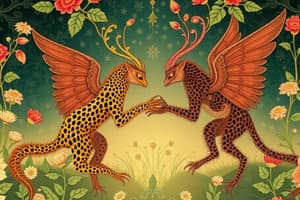Podcast
Questions and Answers
A population of deer is introduced to an island with a limited supply of vegetation. Initially, the deer population grows rapidly, but eventually, the growth rate slows down and stabilizes. Which of the following best explains this phenomenon?
A population of deer is introduced to an island with a limited supply of vegetation. Initially, the deer population grows rapidly, but eventually, the growth rate slows down and stabilizes. Which of the following best explains this phenomenon?
- The deer population has adapted to consume a wider variety of food sources, reducing competition.
- The deer population has exceeded the carrying capacity of the island, leading to increased intraspecific competition for food. (correct)
- The deer population has attracted new predators to the island, leading to increased mortality rates.
- The deer population has started to exhibit interspecific competition with other herbivores on the island.
In a forest ecosystem, two male bird species with similar diets compete for nesting sites. One species is more aggressive and tends to displace the other from the best locations. Over time, what is the most likely outcome of this intraspecific competition?
In a forest ecosystem, two male bird species with similar diets compete for nesting sites. One species is more aggressive and tends to displace the other from the best locations. Over time, what is the most likely outcome of this intraspecific competition?
- The less aggressive bird species will migrate to a new habitat with less competition.
- The less aggressive bird species will evolve to use different food sources, reducing competition.
- Both species will learn to cooperate and share nesting sites equally.
- The more aggressive bird species will gain a reproductive advantage, leading to a shift in population size between the two species (correct)
Which of the following scenarios best illustrates intraspecific competition influencing the evolution of ornamental features?
Which of the following scenarios best illustrates intraspecific competition influencing the evolution of ornamental features?
- Male peacocks develop brighter feathers because they have more access to food.
- Male peacocks develop brighter feathers to help them fly faster.
- Male peacocks develop brighter feathers to camouflage themselves from predators.
- Male peacocks with brighter feathers are more successful at attracting mates, leading to a higher prevalence of brightly colored feathers in the population over generations. (correct)
A population of salamanders exhibits varying levels of aggression. Scientists observe that salamanders in areas with high population density tend to be more aggressive than those in less crowded areas. What inference can be drawn from this observation?
A population of salamanders exhibits varying levels of aggression. Scientists observe that salamanders in areas with high population density tend to be more aggressive than those in less crowded areas. What inference can be drawn from this observation?
Territorial marking is a common behavior in many animal species. How does this behavior relate to intraspecific competition?
Territorial marking is a common behavior in many animal species. How does this behavior relate to intraspecific competition?
A population of fish experiences increased competition as its density grows. Which of the following is the most likely consequence of this intraspecific competition?
A population of fish experiences increased competition as its density grows. Which of the following is the most likely consequence of this intraspecific competition?
A forest contains a mix of mature oak trees and young saplings. The mature trees significantly reduce the amount of sunlight reaching the forest floor, hindering the growth of the saplings. This scenario best exemplifies what type of competition?
A forest contains a mix of mature oak trees and young saplings. The mature trees significantly reduce the amount of sunlight reaching the forest floor, hindering the growth of the saplings. This scenario best exemplifies what type of competition?
Which of the following scenarios best demonstrates contest competition within a population of birds?
Which of the following scenarios best demonstrates contest competition within a population of birds?
A remote island has two species of rodents: Species A, which is well-adapted to avoid predators, and Species B, which is more vulnerable. After a new predator is introduced to the island, the population of Species B declines sharply, while Species A remains relatively stable. This is an example of what?
A remote island has two species of rodents: Species A, which is well-adapted to avoid predators, and Species B, which is more vulnerable. After a new predator is introduced to the island, the population of Species B declines sharply, while Species A remains relatively stable. This is an example of what?
Male deer often engage in aggressive antler clashes to determine dominance during mating season. This behavior is an example of what?
Male deer often engage in aggressive antler clashes to determine dominance during mating season. This behavior is an example of what?
Flashcards
Intraspecific Competition
Intraspecific Competition
Competition within the same species for limited resources.
Carrying Capacity
Carrying Capacity
The maximum number of individuals an environment can sustainably support.
Direct Competition (Aggression)
Direct Competition (Aggression)
Direct challenges between individuals of the same species for resources.
Ornamental Features
Ornamental Features
Signup and view all the flashcards
Territory Marking
Territory Marking
Signup and view all the flashcards
Territory
Territory
Signup and view all the flashcards
Interference Competition
Interference Competition
Signup and view all the flashcards
Exploitative Competition
Exploitative Competition
Signup and view all the flashcards
Apparent Competition
Apparent Competition
Signup and view all the flashcards
Study Notes
- Intraspecific competition is when members of the same species compete for limited resources like food, water, mates, and territory.
- Environments have a carrying capacity, which is the maximum number of individuals a territory can sustain.
- Intraspecific competition intensifies when a population exceeds the carrying capacity, decreasing population growth.
- Intense competition can lead to the death of weaker individuals, stabilizing the population size.
- Interspecific competition is similar, but it occurs between different species competing for the same resources.
- Interspecific competition is less frequent and extreme compared to intraspecific competition.
Intraspecific Competition Examples
- Intraspecific competition affects animal life and the environment, leading to several developed adaptations such as:
- Aggression: Individuals directly challenge each other for resources, leading to more aggressive populations.
- More aggressive northern slimy salamanders are more likely to acquire resources.
- Ornamental features: Used to compete for mates and territory.
- Male peacocks and quetzals use brightly colored feathers to attract mates.
- Male deer use antlers to fight for territory and mates.
- Territory marking: Securing territory ensures reproductive success.
- Animals mark territories with songs, calls, intimidation, and scents.
- Male cougars mark their territory with claw markings, feces, and urine, defending it against other males.
- Size: Larger animals often outcompete smaller ones for resources.
- Large oak trees outcompete smaller saplings for nutrients and sunlight.
Intraspecific Competition Interactions
- There are two types of intraspecific interactions.
- Direct mechanism (interference competition): Individuals compete directly for resources.
- Includes agonistic behavior, where individuals claim territory and deny access to others.
- Animals may develop new behaviors to overcome rivals.
- Indirect mechanism: Individuals compete indirectly for resources.
- Indirect mechanism can be exploitative or apparent.
- Exploitative competition: Individuals deplete a shared resource, reducing size and reproductive success.
- Organisms compete for resources without direct interaction.
- A bear catching a fish takes it away from other bears downstream.
- Apparent competition: Occurs among preyed-upon species.
- Increased prey population leads to a larger predator population, decreasing prey survival.
- It can also be where one prey species adapts, causing predators to prey on the other species more heavily.
- Introducing new prey species benefits predators, and weakens existing prey species.
Intraspecific Competition in Ecology
-
Ecology studies two types of intraspecific competition: contest and scramble.
-
Contest competition: Resources are tied to a territory or ranking.
-
Individuals compete for resource-rich territories, driving out competition.
-
There is a clear winner and loser, with the winner securing all resources.
-
Many species use ritualized aggression to avoid injury and energy expenditure.
-
Contest competition results in a stable population; the breeding population remains steady.
-
White-faced capuchin monkeys compete for territories, and successful individuals grow larger and mate more successfully.
-
Scramble competition: Resources are evenly distributed, and individuals can't be excluded.
-
Herbivores and grazing animals exemplify scramble competition.
-
Problems occur when resources are limited.
-
High population leads to insufficient resources, causing a sharp population decline.
-
Scramble competition frequently leads to unstable population dynamics.
Intraspecific Competition Consequences
- Reduced population growth rates: As density increases, the habitat struggles to support the population.
- Weaker individuals, like the young and old, die off due to inability to compete.
- Dispersal: Movement of organisms from one environment to another.
- It can be active (animals making their own decisions) or passive (plants dispersed by air or water).
- Individuals move to achieve a better quality of life
- Dispersal has four phases: emigration, exploration, settlement, and successful breeding.
- Each phase of dispersal has high risk, but the chance to increase fitness outweighs the risks.
- Social dominance: Social behavior arises from conflict.
- Social dominance enhances stability and reduces conflict within a species.
- Thorleif Schjelderup-Ebbe coined "pecking order" to describe hierarchy among chickens.
- Territoriality: Defending territory provides food, shelter, and safe reproduction, avoiding overcrowding.
- Animals defend only the amount of territory necessary to prevent energy depletion.
Studying That Suits You
Use AI to generate personalized quizzes and flashcards to suit your learning preferences.
Description
Intraspecific competition occurs within the same species for limited resources. As population exceeds carrying capacity, competition intensifies, impacting population growth. Interspecific competition involves different species competing for resources.




